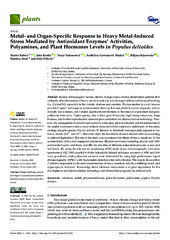Приказ основних података о документу
Metal- and organ-specific response to heavy metal-induced stress mediated by antioxidant enzymes’ activities, polyamines, and plant hormones levels in Populus deltoides
| dc.creator | Kebert, Marko | |
| dc.creator | Kostić, Saša | |
| dc.creator | Vuksanović, Vanja | |
| dc.creator | Gavranović Markić, Anđelina | |
| dc.creator | Kiprovski, Biljana | |
| dc.creator | Zorić, Martina | |
| dc.creator | Orlović, Saša | |
| dc.date.accessioned | 2023-01-10T12:48:26Z | |
| dc.date.available | 2023-01-10T12:48:26Z | |
| dc.date.issued | 2022 | |
| dc.identifier.issn | 2223-7747 | |
| dc.identifier.uri | http://fiver.ifvcns.rs/handle/123456789/3257 | |
| dc.description.abstract | Besides anthropogenic factors, climate change causes altered precipitation patterns that indirectly affect the increase of heavy metals in soils due to hydrological effects and enhanced leaching (i.e., Cd and Ni), especially in the vicinity of mines and smelters. Phytoextraction is a well-known, powerful “green” technique for environmental clean-up that uses plants to extract, sequester, and/or detoxify heavy metals, and it makes significant contributions to the removal of persistent inorganic pollutants from soils. Poplar species, due to their growth features, high transpiration rate, large biomass, and feasible reproduction represent great candidates for phytoextraction technology. However, the consequences of concomitant oxidative stress upon plant metabolism and the mechanism of the poplar’s tolerance to heavy metal-induced stress are still not completely understood. In this study, cuttings of poplar species (Populus deltoides W. Bartram ex Marshall) were separately exposed to two heavy metals (Cd2+ and Ni2+) that were triple the maximum allowed amount (MAA) (according to national legislation). The aim of the study was to estimate the effects of heavy metals on: (I) the accumulation of free and conjugated polyamines, (II) plant hormones (including abscisic acid-ABA and indole-3-acetic acid-IAA), and (III) the activities of different antioxidant enzymes at root and leaf levels. By using the selected ion monitoring (SIM) mode of gas chromatography with mass spectrometry (GC/MS) coupled with the isotopically labeled technique, amounts of ABA and IAA were quantified, while polyamine amounts were determined by using high-performance liquid chromatography (HPLC) with fluorometric detection after derivatization. The results showed that P. deltoides responded to elevated concentrations of heavy metals in soils by exhibiting metal- and organ-specific tolerance. Knowledge about tolerance mechanisms is of great importance for the development of phytoremediation technology and afforestation programs for polluted soils. | sr |
| dc.language.iso | en | sr |
| dc.publisher | Basel : MDPI | sr |
| dc.relation | The Provincial Secretariat for Higher Education and Scientific Research through the project ‘Influence of specific factors in urban environment on alley trees vitality’ (Contract No. 142-451-2558/2021-01/2) | sr |
| dc.relation | info:eu-repo/grantAgreement/MESTD/inst-2020/200197/RS// | sr |
| dc.relation | info:eu-repo/grantAgreement/MESTD/inst-2020/200117/RS// | sr |
| dc.rights | openAccess | sr |
| dc.rights.uri | https://creativecommons.org/licenses/by/4.0/ | |
| dc.source | Plants - Basel | sr |
| dc.subject | cadmium | sr |
| dc.subject | nickel | sr |
| dc.subject | phytoremediation | sr |
| dc.subject | plant hormones | sr |
| dc.subject | polyamines | sr |
| dc.subject | poplar | sr |
| dc.subject | Populus deltoides | sr |
| dc.title | Metal- and organ-specific response to heavy metal-induced stress mediated by antioxidant enzymes’ activities, polyamines, and plant hormones levels in Populus deltoides | sr |
| dc.type | article | sr |
| dc.rights.license | BY | sr |
| dc.citation.issue | 23 | |
| dc.citation.rank | M21 | |
| dc.citation.spage | 3246 | |
| dc.citation.volume | 11 | |
| dc.identifier.doi | 10.3390/plants11233246 | |
| dc.identifier.fulltext | http://fiver.ifvcns.rs/bitstream/id/9171/bitstream_9171.pdf | |
| dc.identifier.scopus | 2-s2.0-85143622957 | |
| dc.type.version | publishedVersion | sr |


